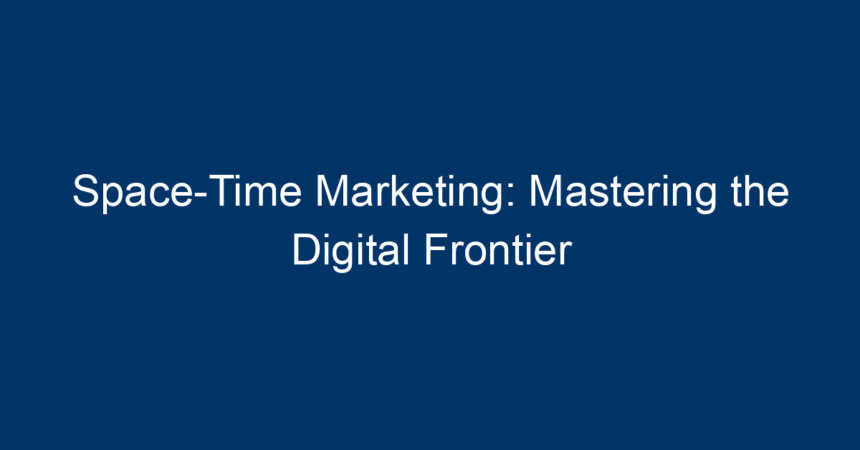In today’s fast-paced digital landscape, where consumer attention is fleeting, businesses must adapt to stay relevant. This is where the concept of space-time marketing comes into play. By understanding how to effectively use both social and physical presence (space) and timing, brands can connect with their audiences in a meaningful way. This article will delve deep into the intricacies of space-time marketing and provide actionable strategies for mastering this innovative approach.
Understanding Space-Time Marketing
What is Space-Time Marketing?
Space-time marketing refers to the strategic approach in which businesses leverage both the physical and digital spaces to engage consumers at the right moment. It combines elements of traditional marketing with cutting-edge digital tactics. By focusing on the dimensions of space and time, brands can create multi-dimensional experiences that resonate with their customers.
The Importance of Space and Time in Marketing
The interplay of space and time is crucial in marketing. Space dictates where the message is delivered, whether via online platforms or physical storefronts. Timing reflects when the message is delivered, significantly influencing consumer behavior. Research shows that targeted marketing efforts that align with the consumer’s state of mind and physical context yield higher engagement rates.
The Pillars of Space-Time Marketing
To effectively implement space-time marketing, brands must focus on three key pillars: Understanding the Audience, Seamless Integration, and Timing Strategies.
1. Understanding the Audience
Demographics and Psychographics
The first step in mastering space-time marketing is to truly understand your audience. Demographic data provides insights into age, location, gender, and income, while psychographics delve into values, interests, and lifestyles. By combining these data sets, businesses can create detailed buyer personas that inform marketing strategies.
Behavioral Insights
Analyzing consumer behavior across both online and offline channels can uncover patterns in how your audience interacts with your brand. Tools like Google Analytics and customer feedback platforms can provide valuable insights, allowing brands to tailor their messaging and promotional strategies effectively.
2. Seamless Integration of Spaces
Online vs. Offline Marketing
In a world where online and offline shopping experiences are increasingly blended, businesses must ensure that their marketing strategies are integrated. This can be achieved through:
-
Omni-channel Marketing: Creating a unified customer experience across various platforms, ensuring that messaging is consistent whether consumers are browsing your website or visiting your physical store.
- Localized Marketing: Using tools like Google My Business can help local businesses target consumers in their vicinity with contextually relevant promotions, driving foot traffic into stores.
Case Study: Successful Integration
Consider the example of Starbucks, which expertly uses space-time marketing. Their mobile app allows customers to order ahead, in turn reducing wait times and creating a seamless transition from digital order to physical store experience. This integration enhances customer satisfaction and fosters brand loyalty.
3. Timing Strategies
Real-Time Marketing
Incorporating real-time marketing techniques involves responding instantly to current events or trends. The beauty of digital marketing lies in its immediacy, allowing brands to pivot their messages to match current conversations. Successful real-time marketing requires agility and a finger on the pulse of global trends.
Seasonal Marketing
Seasonality also plays a significant role in timing strategies. Brands can leverage holidays, seasons, or special events to create promotions that resonate with consumer sentiment. Marketing campaigns that align with these seasons can aid in driving higher engagement and sales.
Tools to Master Space-Time Marketing
To maximize the effectiveness of space-time marketing, businesses can utilize a variety of tools that enhance both online and offline engagement.
1. Customer Relationship Management (CRM) Systems
CRM systems help businesses manage interactions with customers by collecting data that enables personalized marketing. This information is crucial for understanding when and where to deliver messages to your audience effectively.
2. Location-Based Marketing Tools
Tools such as geofencing enables businesses to send targeted promotions to consumers as they enter a specific geographical area. This function can significantly enhance customer engagement and drive conversions.
3. Advanced Analytics
Utilizing platforms like Google Analytics, HubSpot, or social media insights can provide brands with real-time data concerning the success of their marketing efforts. Businesses can continually track performance and make live adjustments based on user interactions.
Challenges in Space-Time Marketing
Despite the numerous benefits, there are certain challenges associated with space-time marketing:
1. Data Privacy Concerns
As brands collect more consumer data to tailor their marketing efforts, they must navigate complex data privacy regulations like GDPR and CCPA. Ensuring consumer trust is paramount while utilizing data for personalization.
2. Integration Difficulties
Many businesses struggle to achieve seamless integration between their online and offline marketing efforts. A cohesive strategy requires a well-coordinated approach, which can be resource-intensive.
3. Rapidly Changing Consumer Behavior
Consumer preferences and behaviors are in a constant state of flux. Brands must be agile and willing to adapt their strategies, using insights gleaned from ongoing analytics to adjust campaigns on the fly.
Actionable Insights for Mastering Space-Time Marketing
1. Build Comprehensive Customer Profiles
Invest time in developing detailed profiles that contain demographic, psychographic, and behavioral data. This foundation will serve as the backbone for future marketing endeavors.
2. Leverage Social Media for Real-Time Engagement
Stay active on social media to engage with customers in real-time. Running live polls, responding to comments swiftly, and participating in trending conversations can significantly enhance brand visibility.
3. Create Integrated Campaigns
Develop marketing campaigns that are consistent across all platforms, allowing for a seamless transition between online and offline engagement. Ensure that promotions are reinforced through both digital ads and in-store offerings.
4. Test and Iterate
Employ A/B testing when launching campaigns to understand what resonates with your audience. Regularly assess campaign performance and be prepared to make real-time adjustments based on analytics.
5. Embrace Technology
Invest in advanced marketing tools that provide valuable insights and facilitate better customer engagement. As technologies evolve, businesses that adapt will be best positioned to capitalize on new opportunities in space-time marketing.
Conclusion
Space-time marketing is an exciting and essential approach for businesses operating in today’s complex digital landscape. By focusing on the interplay of audience understanding, seamless integration, and timing strategies, brands can create impactful marketing campaigns that resonate. Embrace these actionable insights to master the digital frontier and build a lasting connection with your consumers. As you navigate the ever-evolving world of marketing, utilize technology and real-time data to stay ahead, ensuring that your brand not only survives but thrives.




